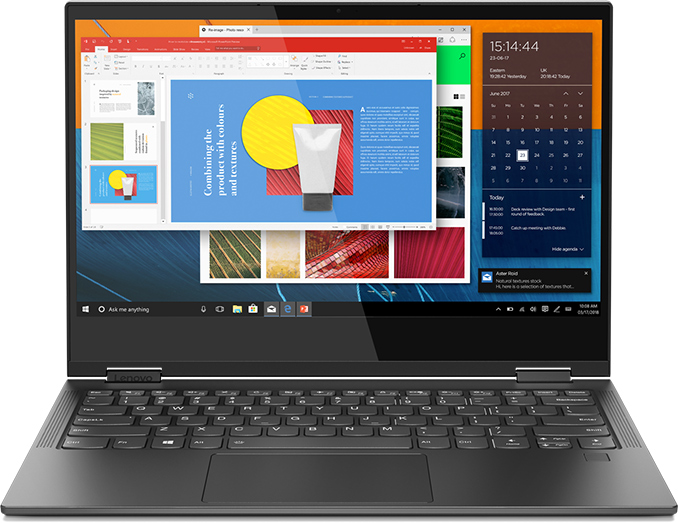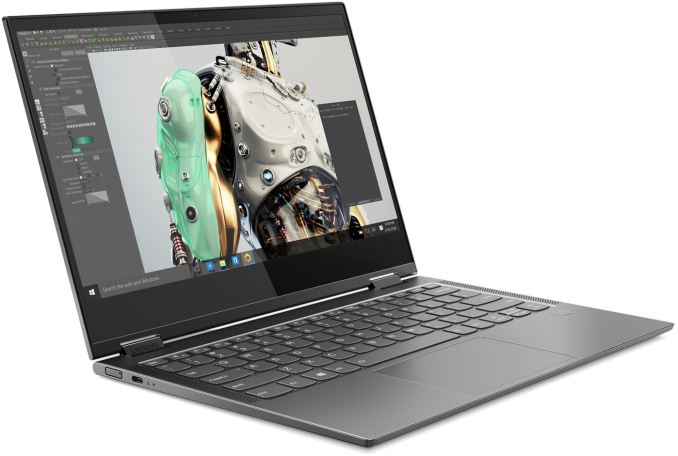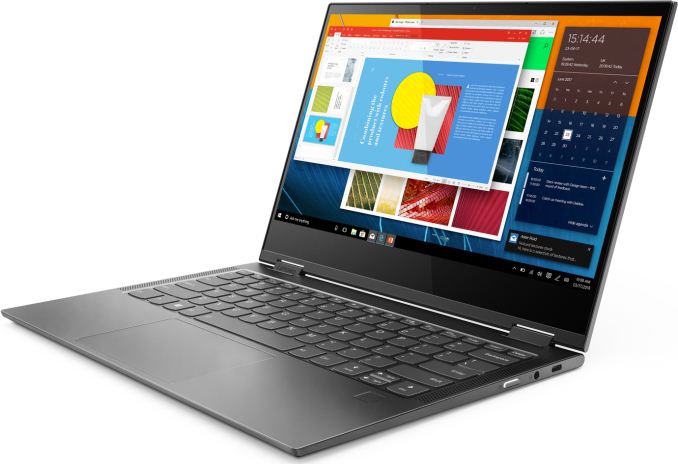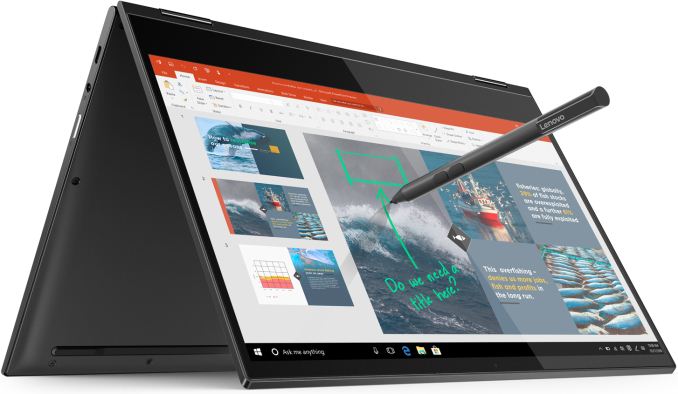Lenovo Announces Yoga C630: The First Windows on Snapdragon 850
by Anton Shilov on August 31, 2018 8:00 AM EST
Lenovo on Thursday introduced the world’s first laptop based on Qualcomm’s Snapdragon 850 SoC. The Yoga C630 promises to deliver a considerably higher performance than the first-generation Windows-on-Snapdragon machines because of SoC improvements as well as optimizations made to the OS. Lenovo says that the Yoga C630 can work for over 25 hours on one charge, thus beating every other convertible PC available today.
Lenovo’s Yoga C630 comes in a convertible laptop form-factor featuring a 13.3-inch Full-HD display with multitouch support. The notebook is made of aluminum, it is just 12.5 mm thick and weighs about 1.2 kilograms, thus being both thinner and lighter than the company’s previous-gen Miix 630 2-in-1 detachable PC powered by the Snapdragon 835. Being based on a mobile SoC, the Yoga C630 does not require any fans and therefore does not produce any noise.
As noted above, the Lenovo Yoga C630 is based on the Qualcomm Snapdragon 850 SoC featuring eight cores and Adreno 630 GPU. The chip is accompanied by 4 or 8 GB LPDDR4X memory as well as 128 GB or 256 GB of solid-state storage featuring a UFC 2.1 interface. As for wireless connectivity, the convertible laptop naturally has an integrated Snapdragon X20 LTE modem that supports up to 1.2 Gbps speeds over appropriate networks as well as a 802.11ac Wi-Fi controller that also supports Bluetooth 5. In addition, the system has two USB Type-C ports, a fingerprint reader, a webcam, stereo speakers, a microphone, and an audio jack for headsets.
Qualcomm itself promises that its Snapdragon 850 offers a 30% higher performance, a 20% longer battery life, and a 20% higher Gigabit LTE speeds when networks permit. That said, it is more than reasonable to expect systems based on the S850 to be faster than notebooks powered by the S835 right out of the box. Meanwhile, there are other important factors that makes Arm-powered Windows 10 systems more attractive in general: Microsoft has re-optimized its Edge browser for the WoS (Windows on Snapdragon) device, whereas Qualcomm has implemented a 64-bit SDK for developers looking to optimize their code for the WoS. Assuming that software makers are interested in the platform, they will release optimized versions of their programs in the coming months or quarters.
With a more compact design, a lower weight, a longer battery life, and a higher performance right out of the box, the Lenovo Yoga C630 looks better than the Miix 630 in every possible aspect. Obviously, software compatibility and performance in applications that run via emulation might still be a question, but Qualcomm and Microsoft are working on issues and all companies involved state that the market these devices are aiming for use UWP programs anyway.
| The Lenovo Yoga C630 | ||
| Specifications | ||
| Display | 13.3" IPS 1920×1080 |
|
| CPU | Qualcomm Snapdragon 850 4 × Kryo 385 Gold - 2.95 GHz, 4 × 256 KB L2 4 × Kryo 385 Silver - 1.80 GHz, 4 × 128 KB L2 |
|
| Graphics | Adreno 630 at 710 MHz (737 GFLOPS) | |
| RAM | 4 GB or 8 GB LPDDR4X | |
| Storage | 128 GB or 256 GB UFS 2.1 | |
| Wi-Fi | 2×2 802.11ac/ad Wi-Fi | |
| Bluetooth | Bluetooth 5 | |
| WWAN | Qualcomm X20 Gigabit LTE | |
| USB | 3.0 | 2 × Type-C |
| Cameras | Front | Webcam with IR and Windows Hello |
| Rear | None | |
| Other I/O | Microphone, stereo speakers, audio jack, trackpad, etc. | |
| Battery | ? Wh | |
| Battery Life | 25 hours | |
| Dimensions | Width | 306.8 mm | 12.08" |
| Height | 216.9 mm | 8.52" | |
| Thickness | 12.5 mm | 0.49" | |
| Weight | 1.2 kilograms | 2.6 lbs | |
Lenovo’s Yoga C630 convertible laptop will hit the market in EMEA region already in September at prices starting from €999. The company will start sales of the hybrid WoS notebook in the U.S. sometimes in November with MSRPs from $849.99, which is actually cheaper than the price of the Miix 630.
Related Reading
- Lenovo’s Miix 630 Snapdragon 835-Based 2-in-1 Now Available
- Qualcomm Announces Snapdragon 850: A Second Generation For Windows
- HP’s Snapdragon 835-Based Envy X2 2-in-1 Available for Pre-Order, Starts at $999
- Lenovo Unveils Miix 630 2-in-1: Windows 10 S, Snapdragon 835, Gigabit LTE, 20 Hrs
- ASUS Announces the NovaGo (TP370): A Snapdragon 835 based Windows 10 PC
- Microsoft Launches Windows 10 On ARM: Always Connected PCs
- Microsoft and Qualcomm Collaborate to Bring Windows 10 & x86 Emulation to Snapdragon Processors














24 Comments
View All Comments
Valantar - Friday, August 31, 2018 - link
In theory, this is an attractive laptop, but the pricing alone means I'd never consider it. Even if the performance improves enough to compete with, say, an i3 (which would be sufficient for basic home/office use), for the same money I could get an XPS 13 which would be faster and lighter. Sure, I'd lose the Yoga and pen functionality and 10 hours of (manufacturer spec) battery life, but 15-ish hours is still plenty. Get these down to the $600 range, and we're talking. Is Qualcomm really charging as much as Intel for these chips?MananDedhia - Friday, August 31, 2018 - link
I would definitely disagree that the steep price is due to the processor. This has a solid state drive. And the biggest one is the novelty factor. Once Windows, Qualcomm and other vendors are able to hammer out the kinks in the implementation, the market will be flooded with these things and prices will come down subsequently.vanilla_gorilla - Friday, August 31, 2018 - link
Other premium laptops are around this same price using i3 processors (e.g., Dell XPS 13 starts at $799 with an i3, 4GB of RAM and 128GB SSD). The question is, are people willing to trade performance to get a massive increase in battery life and integrated LTE. If you use mostly web based applications I don't think the lack of software compatibility or x86 emulation overhead will be much of an issue.Samus - Saturday, September 1, 2018 - link
The Surface Go has an SSD, and can be equipped with 128GB and a keyboard for hundreds less than this thing.Let's be honest, too. Even the Pentium Gold is going to slaughter this thing in performance.
vanilla_gorilla - Saturday, September 1, 2018 - link
The Surface Go only has a 10" display, no keyboard included, or an awful one you can buy, optional LTE ($$$) and only 9 hours of battery life. Add in a keyboard and a model with LTE, upgrade to the 128GB SSD (64GB base) and you're probably at $650 (guessing?) and still have a tiny display and less than half the battery life? I'd definitely take the Yoga over that.sing_electric - Thursday, September 6, 2018 - link
You're pretty close; with the type cover the upper model surface is $680, and I'm not aware of there being an LTE version.At first, I was going to say that the comparison between the two isn't great, except I really think that the Surface Go's performance and 10" screen mean its more of a companion device (in other words, it can't be the only laptop you've got if you need it for work, or writing long papers in school), and I highly suspect that the performance of the Snapdragon 850 will put the Lenovo in the same category, especially since there will be times when there'll be an x86 app running in a pretty slow emulation layer.
ragenalien - Friday, August 31, 2018 - link
I think it's less about the cost of the snapdragon chip and more about the other components. With intel stuff they already have boards tested and ready to go. They likely even have a very streamlined process for getting things tested and to market which makes it cheaper and it's already at a large scale. With these the scale is smaller, which makes every other part more expensive, they have to do more testing (likely) given that it's a completely new device, and they're likely just trying to see what the market will absorb with them.eastcoast_pete - Friday, August 31, 2018 - link
Agree on the price being too high. At ~$600, the price/value proposition would be more compelling. This is a bad pricing strategy: (over) charging at launch means low sales, which might bring down prices later due to large inventory, but by then, the novelty factor is gone. Charge a decent price at launch, and Lenovo would be much more likely to get the uptake they want. Lenovo, hit Qualcomm up for a discount (direct or a coupon for buyers), they want to get into the notebook/convertible space badly enough to take a hit up front.sing_electric - Thursday, September 6, 2018 - link
I suspect the Snapdragon SoC isn't really driving the price here, and is probably competitive with a Pentium Gold (or maybe i3?) machine by the time you put in WiFi and LTE.The pricing, I'm betting, comes from Lenovo figuring that there's a certain segment of corporate customers who are willing to pay for the battery life, AND who see the ARM platform as a security feature, rather than a performance hamper.
randomhkkid - Friday, August 31, 2018 - link
I wonder is the 26% IPC uplift will be enough to alleviate the sluggish-ness of the first generation. That said the 61Whr battery should lead to some monstrous battery life.